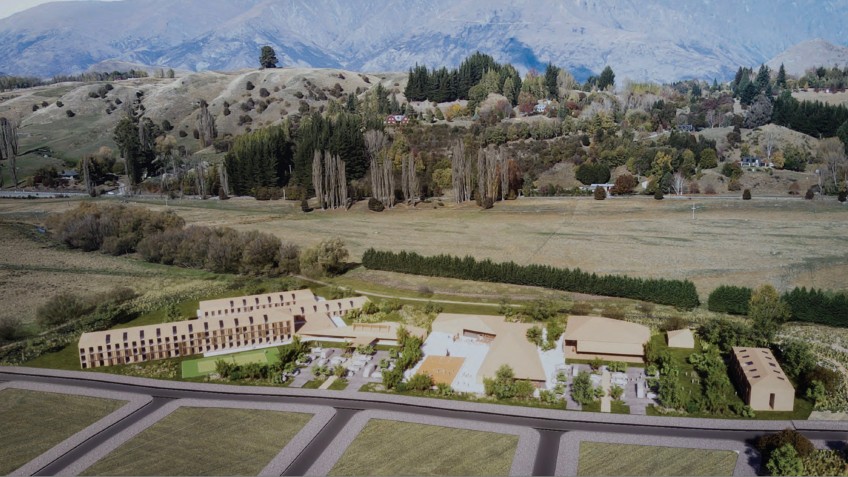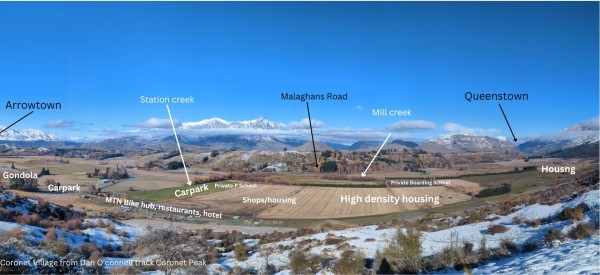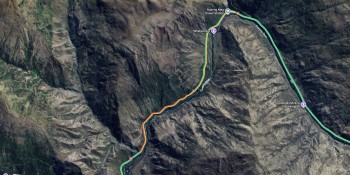'Planned growth swapped for opportunistic development': Coronet Village opponent

A residents group set up to raise concerns about an ambitious gondola and village proposal for a rural landscape between Arthurs Point and Arrowtown claims a streamlined consenting process has seen planned growth swapped out for opportunistic development.
Tit for tat statements continue between the instigators of and opponents to the fast track eligible Coronet Peak Village - a mixed-use development at the base of Coronet Peak to be linked by gondola to the ski field.
The Malaghans Valley Protection Society (MVPS) set up in September in response to news of the proposal and it claims opposition is mounting in response to the project being included in the coalition government's Fast-track Approvals Bill.

Coronet Village's gondola base as illustrated in its successful application to central government for inclusion in the Fast-track Approvals Bill (Image: Supplied).
In a statement yesterday, the group says its membership has grown to more than 200 members and local experts are now providing insight and advice, warning of the knock-on effects if the development is to proceed.
“With fast track, planned growth has been swapped for opportunistic development," group chairman James Hall says in the statement.
"It is the further afield and unintended consequences we will all pay for down the track. MVPS is not anti-development, we are pro-development that makes sense."
Mr Hall says the group will continue lobbying the government and gathering additional support from the community.
“It concerns me that Coronet Village was accepted by the advisory panel when no environmental impacts were considered, and there was no independent ratification or information from third parties. They were totally reliant on the applicant’s information,” Mr Hall says.
“Bernard Cleary and the consortium have stated last week that they may scale things back and talk to the community, and we look forward to that. They have also shared their plans for Coronet Village with us over the weekend which is a good step. It means we now can have a more constructive discussion."
Mr Hall is referencing a statement released by the consortium on October 17, where some players appear to distance themselves from certain aspects of the proposal.
The statement acknowledges some discontent within the community, particularly in regards to flagged high-density residential development at the site, the scope and nature of which will now be reviewed.
Mr Hall, of MVPS, says experts his group is working with include Bruce McLeod from Aurum Survey Consultants, Paddy Baxter from Baxter Design, and Glenn Davis from E3 Scientific, in addition to Mana Tāhuna and tourism company AuthenticAs, who have also provided their insight.
Mr McLeod is questioning the appropriateness of the site for development due to its remoteness to services and the pressure that would place on existing stretched networks.
“Residents would need to drive everywhere and any eco-gains from the gondola would be offset substantially by trying to heat shaded homes and dispose of effluent," he says in the statement.
"Instead of developing a damp, cold site in the upper catchment of Lake Hayes, we should be intensifying the existing urban areas with density next to existing service hubs."
Meanwhile Mr Baxter says it appears that the scale of the Coronet Village development would be contrary to the key relevant landscape-related objectives and policies of the Operative and Proposed District Plans.
“These objectives and policies are in place so the amenity values (or quality) of the environment are maintained or enhanced by any development," he says in the statement.
"From the information that has been made public, it appears that Coronet Village does not avoid, remedy or mitigate adverse effects of activities on the environment, and does not maintain or enhance the landscape character."

The Malaghans Valley Protection Society thinks Coronet Village appears more like 'a new town' (Image: Supplied).
The land is also located far from the defined urban growth areas and in an area with known natural hazard risks, MVPS argues.
"There are many other areas in the Whakatipu basin without such natural hazards that MVPS believes would be far better for development."
Mr Davis has added his voice to those concerned about Lake Hayes and water quality in the wider catchment, and the impact of increased development in it.
He says there has been significant catchment remedial work designed to reduce sediment loads in waterways and starve the lake of nutrients but Coronet Village and the resultant discharge of wastewater from 780 houses presents a considerable risk.
“The sensitivity of the lake cannot be overstated. A fast-track process that promotes economic activity ahead of environmental protection could simply exacerbate the poor catchment decisions of the past and undo the hard work and investments made by the local community to restore the water quality of Lake Hayes,” he in the statement.
MVPS says Mana Tāhuna, a charitable trust heavily involved with catchment restoration, has also connected with them on the issue.
“Mana Tāhuna has worked hard the last four years to restore and protect our precious taonga in the Wai Whakaata (Lake Hayes) catchment. We have had no involvement or engagement from the developers proposing the subdivision in Dalefield. Our view is any future development in our rohe, especially Wai Whakaata, must not be at the expense of our whenua,” a representative from Mana Tāhuna says in the statement.
In addition to the impacts on infrastructure and waterways, there is major concern about the effects on the quality of the night skies of Malaghans Valley and Coronet Peak.
Simon Williams has developed and runs the AuthenticAs Starry Night Adventures. He has major concerns about the impact Coronet Village and other fast-track developments within Queenstown will have on the area's dark sky environment.
“The dark sky corridor that exists between Arthurs Point and Arrowtown, and its close proximity to a worldwide tourism mecca, makes it one of the best in the world,” Mr Williams says in the statement.
The project is flagged in government documents to include a mountain bike facility, a restaurant at the summit of Coronet Peak, a base for local conservation charity Te Tapu o Tāne, a boarding high school, a primary school, and a comprehensive subdivision up to 780 residential units, alongside public roading and wastewater infrastructure.
It is one of 10 projects for inland Otago selected for inclusion in the government's bill.
'Essentially a new town' - concerns over Coronet gondola village plans
Coronet Village scope being reconsidered
Main image (Supplied): Schools, a conservation base, a mountain biking hub - an artist's impression of a slice of the proposed Coronet Village.

























